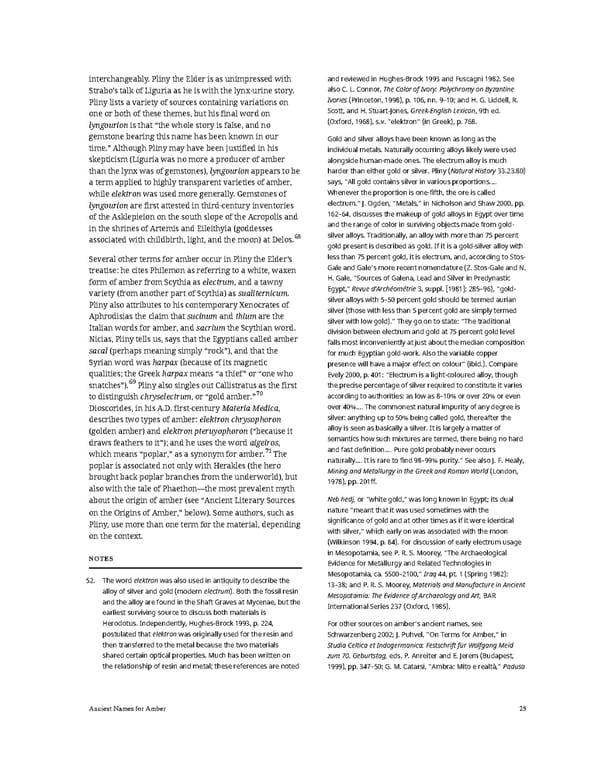interchangeably. Pliny the Elder is as unimpressed with and reviewed in Hughes-Brock 1993 and Fuscagni 1982. See Strabo’s talk of Liguria as he is with the lynx-urine story. also C. L. Connor, The Color of Ivory: Polychromy on Byzantine Pliny lists a variety of sources containing variations on Ivories (Princeton, 1998), p. 106, nn. 9–10; and H. G. Liddell, R. one or both of these themes, but his final word on Scott, and H. Stuart-Jones, Greek-English Lexicon, 9th ed. lyngourion is that “the whole story is false, and no (Oxford, 1968), s.v. “elektron” (in Greek), p. 768. gemstone bearing this name has been known in our Gold and silver alloys have been known as long as the time.” Although Pliny may have been justified in his individual metals. Naturally occurring alloys likely were used skepticism (Liguria was no more a producer of amber alongside human-made ones. The electrum alloy is much than the lynx was of gemstones), lyngourion appears to be harder than either gold or silver. Pliny (Natural History 33.23.80) a term applied to highly transparent varieties of amber, says, “All gold contains silver in various proportions.… whileelektron was used more generally. Gemstones of Whenever the proportion is one-fifth, the ore is called lyngourion are first attested in third-century inventories electrum.” J. Ogden, “Metals,” in Nicholson and Shaw 2000, pp. of the Asklepieion on the south slope of the Acropolis and 162–64, discusses the makeup of gold alloys in Egypt over time in the shrines of Artemis and Eileithyia (goddesses and the range of color in surviving objects made from gold- associated with childbirth, light, and the moon) at Delos.68 silver alloys. Traditionally, an alloy with more than 75 percent gold present is described as gold. If it is a gold-silver alloy with Several other terms for amber occur in Pliny the Elder’s less than 75 percent gold, it is electrum, and, according to Stos- treatise: he cites Philemon as referring to a white, waxen Gale and Gale’s more recent nomenclature (Z. Stos-Gale and N. form of amber from Scythia as electrum, and a tawny H. Gale, “Sources of Galena, Lead and Silver in Predynastic variety (from another part of Scythia) as sualiternicum. Egypt,” Revue d’Archéométrie 3, suppl. [1981]: 285–96), “gold- Pliny also attributes to his contemporary Xenocrates of silver alloys with 5–50 percent gold should be termed aurian Aphrodisias the claim that sucinum and thium are the silver (those with less than 5 percent gold are simply termed Italian words for amber, and sacrium the Scythian word. silver with low gold).” They go on to state: “The traditional Nicias, Pliny tells us, says that the Egyptians called amber division between electrum and gold at 75 percent gold level falls most inconveniently at just about the median composition sacal (perhaps meaning simply “rock”), and that the for much Egyptian gold-work. Also the variable copper Syrian word was harpax(because of its magnetic presence will have a major effect on colour” (ibid.). Compare qualities; the Greek harpax means “a thief” or “one who Evely 2000, p. 401: “Electrum is a light-coloured alloy, though snatches”).69 Pliny also singles out Callistratus as the first the precise percentage of silver required to constitute it varies to distinguish chryselectrum, or “gold amber.”70 according to authorities: as low as 8–10% or over 20% or even Dioscorides, in his A.D. first-century Materia Medica, over 40%.… The commonest natural impurity of any degree is describes two types of amber: elektron chrysophoron silver: anything up to 50% being called gold, thereafter the (golden amber) and elektron pteruyophoron (“because it alloy is seen as basically a silver. It is largely a matter of draws feathers to it”); and he uses the word aigeiros, semantics how such mixtures are termed, there being no hard which means “poplar,” as a synonym for amber.71 The and fast definition.… Pure gold probably never occurs poplar is associated not only with Herakles (the hero naturally.… It is rare to find 98–99% purity.” See also J. F. Healy, brought back poplar branches from the underworld), but Mining and Metallurgy in the Greek and Roman World (London, also with the tale of Phaethon—the most prevalent myth 1978), pp. 201ff. about the origin of amber (see “Ancient Literary Sources Neb hedj, or “white gold,” was long known in Egypt; its dual on the Origins of Amber,” below). Some authors, such as nature “meant that it was used sometimes with the Pliny, use more than one term for the material, depending significance of gold and at other times as if it were identical on the context. with silver,” which early on was associated with the moon (Wilkinson 1994, p. 84). For discussion of early electrum usage NOTES in Mesopotamia, see P. R. S. Moorey, “The Archaeological Evidence for Metallurgy and Related Technologies in 52. The wordelektron was also used in antiquity to describe the Mesopotamia, ca. 5500–2100,” Iraq 44, pt. 1 (Spring 1982): alloy of silver and gold (modern electrum). Both the fossil resin 13–38; and P. R. S. Moorey, Materials and Manufacture in Ancient and the alloy are found in the Shaft Graves at Mycenae, but the Mesopotamia: The Evidence of Archaeology and Art, BAR earliest surviving source to discuss both materials is International Series 237 (Oxford, 1985). Herodotus. Independently, Hughes-Brock 1993, p. 224, For other sources on amber’s ancient names, see postulated that elektron was originally used for the resin and Schwarzenberg 2002; J. Puhvel, “On Terms for Amber,” in then transferred to the metal because the two materials Studia Celtica et Indogermanica: Festschrift für Wolfgang Meid shared certain optical properties. Much has been written on zum 70. Geburtstag, eds. P. Anreiter and E. Jerem (Budapest, the relationship of resin and metal; these references are noted 1999), pp. 347–50; G. M. Catarsi, “Ambra: Mito e realtà,” Padusa Ancient Names for Amber 25
 Ancient Carved Ambers in the J. Paul Getty Museum Page 34 Page 36
Ancient Carved Ambers in the J. Paul Getty Museum Page 34 Page 36